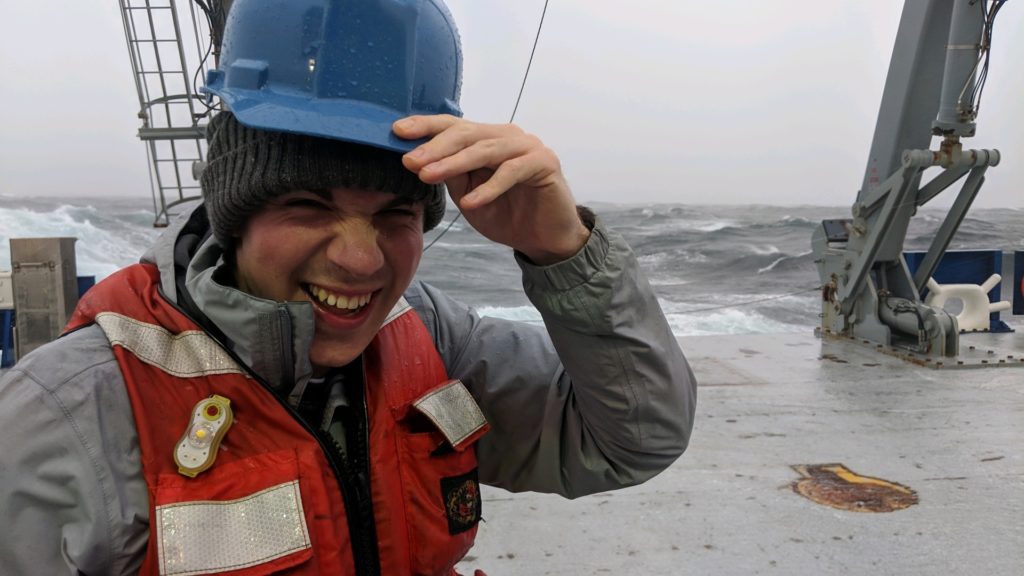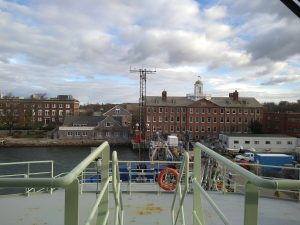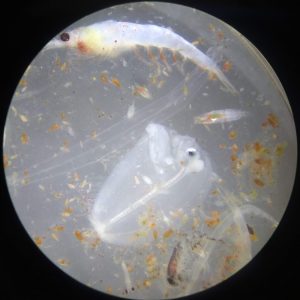Adventures at Sea

(this post was written by Ph.D. student Cory Berger)
My name is Cory Berger, and I’m a new student in the Tarrant lab. I’m still getting settled in to life as a graduate student, but I’ve already had some memorable experiences, and I’m going to be writing about one of them today.
I recently participated in the Joint Program Orientation Cruise, which is an opportunity for first-year students to get some time at sea on the R/V Neil Armstrong. We went straight south from the Cape to the continental shelf break. The scientific objectives of the cruise were to capture hydrographic profiles of temperature, salinity, and current velocity across the shelf-break front, and to collect plankton as part of the Northeast Shelf Long-Term Ecological Research (NES-LTER) program. Finally, we also conducted a deep-water tow to collect fish for the Ocean Twilight Zone Project.

View from the stern while leaving Woods Hole.
As a biology student, my job was to work the plankton nets, both deploying them on deck and sorting through the samples in the lab. We were prepared for rough November weather, and we got it, but on the first day the seas were actually much calmer than forecast, so we were able to complete several “bongo net” tows to collect plankton in the water column. Between tows, we had our hands full sorting through the gunk—and I was shocked at the sheer amount of biomass we collected each time! Drag a net through the water for a few minutes, and you get bucketfuls of microscopic organisms. It no longer seems strange that whales can live off that stuff. We portioned up the plankton into various fractions for different projects: some were preserved in formaldehyde and sent off to be ID’ed morphologically, others were frozen and destined for stable isotope analysis (which tells us about diet and food web structure), and a third group was preserved in ethanol for genetic identification.

A mixed zooplankton sample (or “creepy-crawlies,” if you prefer
Personally, I was just happy to get some time in the field. It was nice to get away from classwork for a while, and a reminder of why I wanted to be a marine biologist in the first place. I have an enduring love for invertebrates, so I found all sorts of exciting creepy-crawlies to look at under the microscope during my down-time (but be warned that the first time you use a microscope on a moving ship might not be so fun). For me, the coolest part of the science was seeing the shift in community composition as we moved across the shelf break. When we were close to shore, we collected a ton of algae in addition to a zooplankton community dominated by shrimp-like amphipods, copepods, and chaetognath worms. Just one station further out, a distance of only about 20 miles, the composition of the gunk was noticeably different, without as much algae but with many large krill—in fact, all of the other zooplankton reached larger body sizes as well. We also collected more fish larvae at this stage.
I’m very grateful for the opportunities that a place like WHOI provides. Science involves a lot of staring at a computer screen, and it’s easy to forget how fun it is to go out and make observations in nature—and of course, doing so at sea is always a special experience. I look forward to the next time I’m able to spend time in the field. There’s really no substitute for hands-on biology!